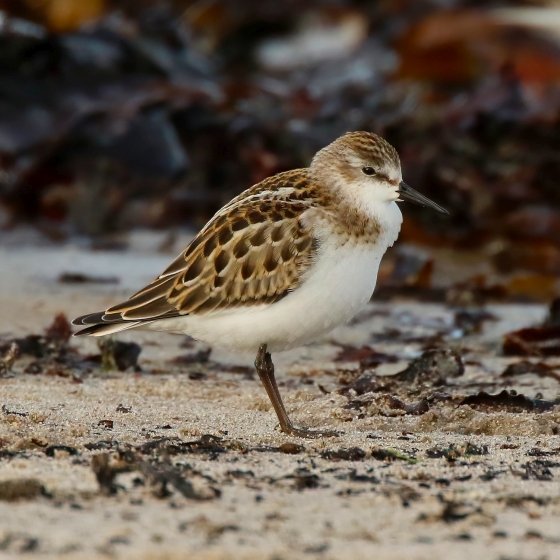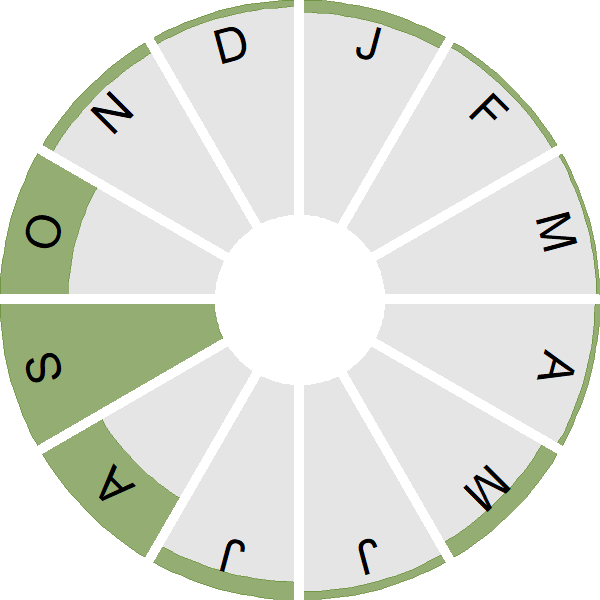Little Stint

Introduction
The smallest of our regularly occurring waders, the Little Stint is mostly recorded on spring and (especially) autumn passage.
About two-thirds the size of Dunlin (with which it is often found), Little Stint can be identified by its shorter, straighter bill. It is typically found on the edge of fresh or brackish water, running and pecking the mud.
Birds passing through Britain breed in northern Scandinavia and north-west Russia and winter in southern Europe and western Africa. One colour-ringed bird was marked on the west coast of Norway on 24 September then identified 3 days later in East Yorkshire having travelled over 1,000 km.

Key Stats
Identification
Songs and Calls
Song:
Flight call:
Status and Trends
Conservation Status
Population Size
Population Change
Little Stint is predominantly a passage migrant in the UK, recorded mostly on autumn migration between late July and October Balmer et al. 2013]. Only a handful of individuals winter in the UK [Frost et al. 2019]. [WeBS data show a peak in numbers recorded in the UK in winter 2000/01, since when numbers have declined; there has been a small increase in numbers seen in the past 15 years. At a flyway scale, the population trend shows a marked decline since the early 1980s [van Roomen 2022].
Distribution
During the 2007–11 winter period, Little Stints were recorded from 108 10-km squares, mostly in the southern half of England and at coastal sites, though inland reservoirs and gravel pits were also utilised.
Occupied 10-km squares in UK
or view it on Bird Atlas Mapstore.
or view it on Bird Atlas Mapstore.
European Distribution Map
Distribution Change
Change in occupied 10-km squares in the UK
or view it on Bird Atlas Mapstore.
Seasonality
Little Stints are passage migrants, most often encountered in autumn when numbers are swelled by returning juveniles; small numbers winter.
Weekly pattern of occurrence
The graph shows when the species is present in the UK, with taller bars indicating a higher likelihood of encountering the species in appropriate regions and habitats.

Movement
Britain & Ireland movement
Foreign locations of birds ringed or recovered in Britain & Ireland
Dots show the foreign destinations of birds ringed in Britain & Ireland, and the origins of birds ringed overseas that were subsequently recaptured, resighted or found dead in Britain & Ireland. Dot colours indicate the time of year that the species was present at the location.
- Winter (Nov-Feb)
- Spring (Mar-Apr)
- Summer (May-Jul)
- Autumn (Aug-Oct)

European movements
EuroBirdPortal uses birdwatcher's records, such as those logged in BirdTrack to map the flows of birds as they arrive and depart Europe. See maps for this species here.
The Eurasian-African Migration Atlas shows movements of individual birds ringed or recovered in Europe. See maps for this species here.
Biology
Productivity and Nesting
Nesting timing
Egg measurements
Clutch Size
Survival and Longevity
Survival is shown as the proportion of birds surviving from one year to the next and is derived from bird ringing data. It can also be used to estimate how long birds typically live.
View number ringed each year in the Online Ringing Report.
lifespan
Biometrics
Wing length and body weights are from live birds (source).
Wing length
Body weight
Ring Size
Classification, names and codes
Classification and Codes
- Order: Charadriiformes
- Family: Scolopacidae
- Scientific name: Calidris minuta
- Authority: Leisler, 1812
- BTO 2-letter code: LX
- BTO 5-letter code: LITST
- Euring code number: 5010
Alternate species names
- Catalan: territ menut comú
- Czech: jespák malý
- Danish: Dværgryle
- Dutch: Kleine Strandloper
- Estonian: väikerüdi e. väikerisla
- Finnish: pikkusirri
- French: Bécasseau minute
- Gaelic: Luatharan-beag
- German: Zwergstrandläufer
- Hungarian: apró partfutó
- Icelandic: Veimiltíta
- Irish: Gobadáinín Beag
- Italian: Gambecchio comune
- Latvian: trulitis
- Lithuanian: mažasis begikas
- Norwegian: Dvergsnipe
- Polish: biegus malutki
- Portuguese: pilrito-pequeno
- Slovak: pobrežník malý
- Slovenian: mali prodnik
- Spanish: Correlimos menudo
- Swedish: småsnäppa
- Welsh: Pibydd Bach

